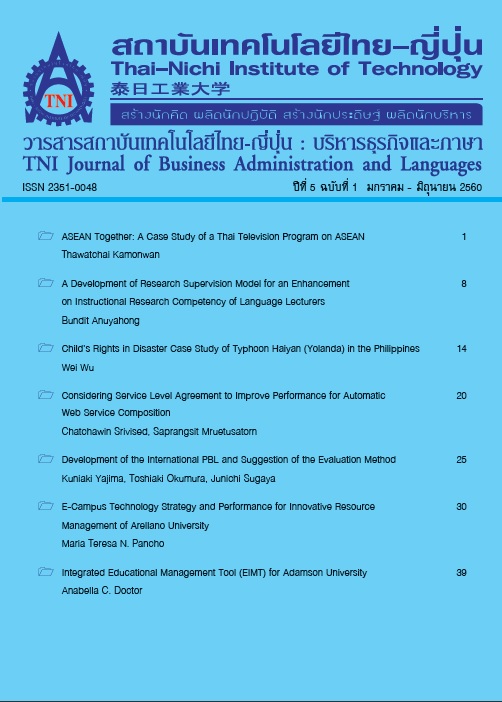Child’s Rights in Disaster Case Study of Typhoon Haiyan (Yolanda) in the Philippines
Main Article Content
Abstract
ASEAN, a developing intergovernmental organization in Southeast Asia region. With a high frequency of human rights issues in the last decade all over the world, besides, series of natural disasters attacked in this region, tsunami, earthquake, flood, haze, typhoon, etc. Natural disaster is the unmodifiable issue, to reduce the damage, needs the cooperation from different sectors, such as government, civil society, medical and technology support, financial support, etc. Children, a special group in the disaster situation, they are facing a higher risk of violence, exploitation, and trafficking, in the meantime, their education and health care are also being worried in disaster situation.
This paper throughs the concept of child’s rights protection, and explores the relationship between the humanitarian relief work and child’s rights protection in the post-disaster period in the case of Typhoon Haiyan (Yolanda), since 2013 until now. To research what is the role of ASEAN in emergency situation to achieve the child’s rights.
Article Details
Article Accepting Policy
The editorial board of Thai-Nichi Institute of Technology is pleased to receive articles from lecturers and experts in the fields of business administration, languages, engineering and technology written in Thai or English. The academic work submitted for publication must not be published in any other publication before and must not be under consideration of other journal submissions. Therefore, those interested in participating in the dissemination of work and knowledge can submit their article to the editorial board for further submission to the screening committee to consider publishing in the journal. The articles that can be published include solely research articles. Interested persons can prepare their articles by reviewing recommendations for article authors.
Copyright infringement is solely the responsibility of the author(s) of the article. Articles that have been published must be screened and reviewed for quality from qualified experts approved by the editorial board.
The text that appears within each article published in this research journal is a personal opinion of each author, nothing related to Thai-Nichi Institute of Technology, and other faculty members in the institution in any way. Responsibilities and accuracy for the content of each article are owned by each author. If there is any mistake, each author will be responsible for his/her own article(s).
The editorial board reserves the right not to bring any content, views or comments of articles in the Journal of Thai-Nichi Institute of Technology to publish before receiving permission from the authorized author(s) in writing. The published work is the copyright of the Journal of Thai-Nichi Institute of Technology.
References
P. Attilio, “Towards an ASEAN human rights mechanism: the ASEAN Commission on the Promotion and Protection of the Rights of Women and Children,” The International Journal of Human Rights, vol. 20, no. 3, pp. 321–342, Apr. 2016.
A. Penrose and M. Takaki, “Children’s rights in emergencies and disasters,” Lancet, vol. 367, no. 9511, pp. 698–699, Feb. 2006.
The International Bank for Reconstruction and Development/The World Bank, “Advancing Disaster Risk Financing and Insurance in ASEAN Member States : Framework and Options for Implementation,” World Bank, Washington, DC, 2012.
L. Lawrence J., The Convention on the Rights of the Child: United Nations Lawmaking on Human Rights (Human Rights in International Perspective), vol. 3. Lincoln, Nebraska, United States: University of Nebraska Press, 1995.
“One Year After Typhoon Haiyan, Philippines,” UNICEF, Philippines, Progress Report UNICEF/PFPG2014-1159.
OCHA (1991). Cluster Coordination [Online]. Available: https:// www.unocha.org/legacy/what-we-do/coordination-tools/cluster-coordination
Save the Children, World Vision, Plan International, and UNICEF, “After Yolanda: What Children Think, Need and Recommend,” Save the Children, Philippines, Dec. 2013.
M. May, “Are we there yet? Children’s views on Haiyan recovery and the road ahead,” Save the Children, Philippines, 2014.
S. Yasuyuki and Z. Fauziah, “Disaster Management in ASEAN,” in ERIA Discussion Paper 2014-03, 2014.

